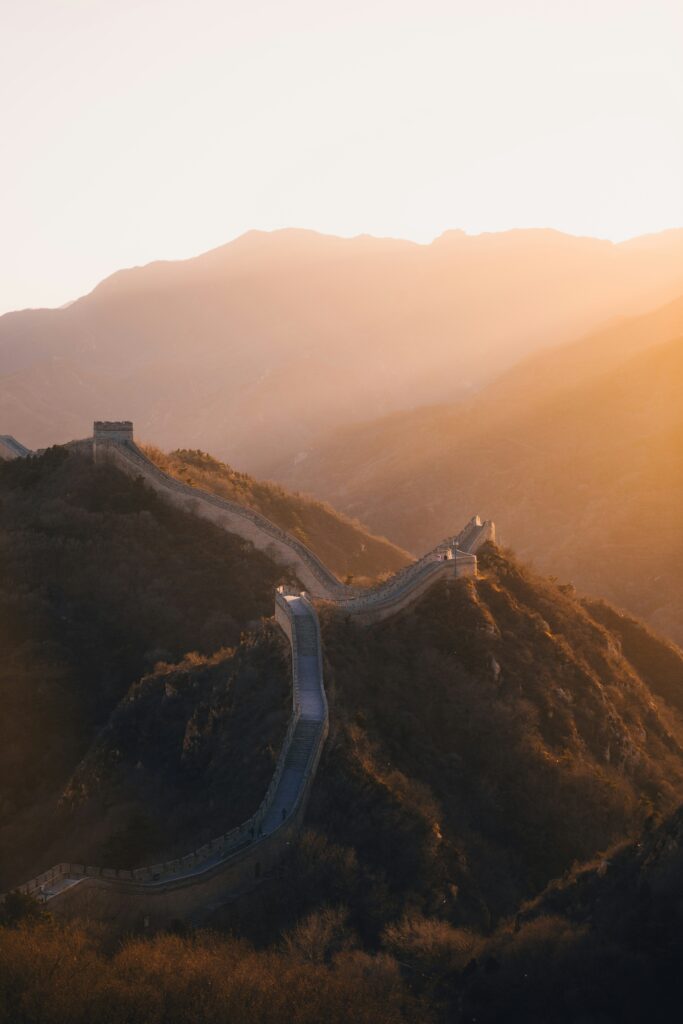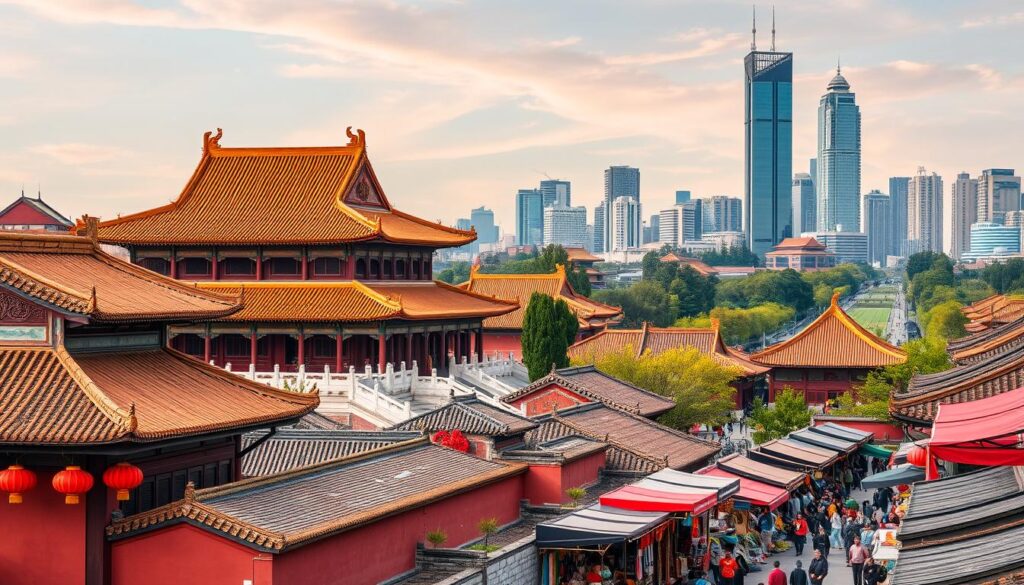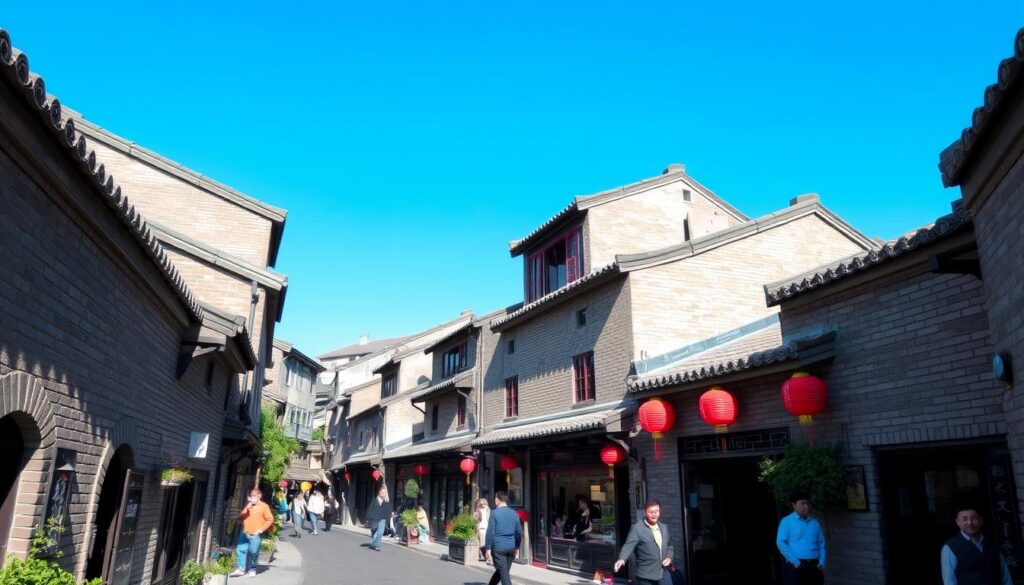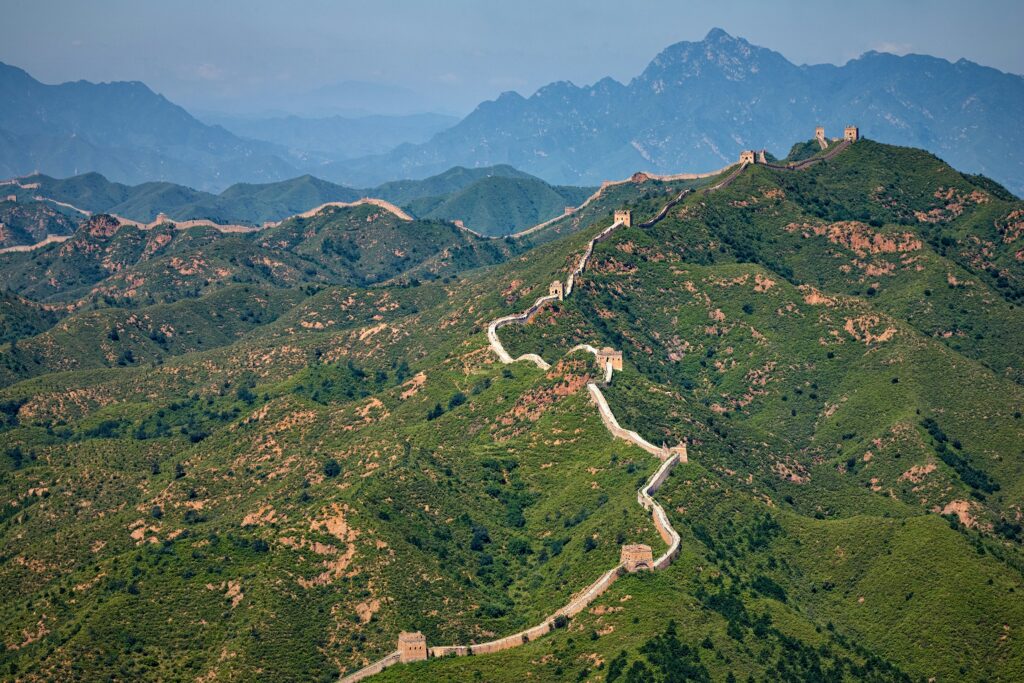Beijing is a city in the heart of China that mixes old and new perfectly. It lets visitors dive into a world of history, culture, and amazing buildings. You can see the grand Forbidden City and the peaceful Temple of Heaven. These places show off China’s incredible past.
But Beijing isn’t just about the past. It also has modern sights that show China’s growth and creativity. Get ready to see the best of Beijing’s old and new attractions.
Key Takeaways
- Discover the perfect balance of Beijing’s historical landmarks and modern marvels.
- Immerse yourself in the rich cultural heritage and architecture of the Forbidden City.
- Marvel at the engineering wonder of the Great Wall of China.
- Experience the serene spirituality of the Temple of Heaven.
- Explore the vibrant blend of traditional and modern in Beijing’s cityscapes.
Unveiling the Grandeur of the Forbidden City
The Forbidden City is a key part of Beijing’s history. It was once the only place where China’s emperors lived. This UNESCO World Heritage Site shows off traditional Chinese architecture. It has detailed designs that amaze people from all over.
The Imperial Palace’s Architectural Wonders
Walk through the Forbidden City to see its beautiful halls and courtyards. Each one tells a story of the Ming and Qing dynasties. Look at the roofs, carvings, and colors that make the palace so special.
Exploring the Forbidden City’s Captivating History
Learn about the Forbidden City’s rich history. This is where China’s powerful rulers once ruled their empire. Discover the stories and traditions that have made the Forbidden City what it is today. This will help you understand Chinese history and culture better.
“The Forbidden City is not only a monument to China’s imperial past, but a testament to the ingenuity and craftsmanship of its people.”
| Architectural Features | Historical Significance |
|---|---|
| Ornate roofs and intricate carvings | Reflect the grandeur and power of the imperial court |
| Symmetrical layout and harmonious design | Embody the principles of traditional Chinese architecture |
| Vibrant colors and detailed ornamentation | Symbolize the wealth and prestige of the ruling dynasty |
The Great Wall of China: A Marvel of Ancient Engineering
No visit to Beijing is complete without seeing the Great Wall of China. This massive wall was built over centuries to protect the Chinese empire. It shows the amazing skills and will of ancient Chinese engineers. Walk along the paths that hug the mountains, and be amazed by the wall’s huge size and complexity.
The Great Wall of China isn’t just one wall. It’s a chain of walls and forts across northern China. Built in the Qin, Han, and Ming dynasties, it was meant to keep out invaders. Its location in the mountains made it a strong barrier against invaders.
The wall is more than just a barrier. It shows the creativity and skill of its builders. Millions of workers, including soldiers and locals, built this huge structure. They used stone, brick, and earth, and came up with smart engineering ideas to make it last.
Now, the Great Wall of China is a symbol of Chinese history and the Chinese people’s strength. Visitors to Beijing attractions can see parts of the wall and learn about its history and importance. The wall’s watchtowers and views still amaze and inspire everyone who sees it.
“The Great Wall of China is a wonder of the world, and a trip to Beijing is not complete without experiencing its majesty firsthand.” – [Author Name]
| Fact | Detail |
|---|---|
| Length | The Great Wall of China is approximately 13,171 miles (21,196 km) long, making it one of the longest man-made structures in the world. |
| Construction | The wall was built over centuries, with the majority of the existing structure dating back to the Ming Dynasty (1368-1644). |
| Materials | The wall was constructed using a variety of materials, including stone, brick, rammed earth, and tamped earth, depending on the available resources and the terrain. |
| Purpose | The primary purpose of the Great Wall was to defend the Chinese empire from the incursions of nomadic groups from the northern frontier. |
The Great Wall of China shows the amazing skills and will of ancient Chinese engineers and builders. Visitors to Beijing can see this incredible piece of ancient engineering and dive into the rich Chinese history it represents.

Temple of Heaven: A Serene Oasis of Spirituality
In the heart of Beijing, the Temple of Heaven is a peaceful spot for deep thought. It’s a UNESCO World Heritage Site known for its stunning architecture. This architecture combines traditional Beijing architecture with nature beautifully.
The Remarkable Architecture of the Temple
The temple boasts amazing structures like the Circular Altar and the Hall of Prayer for Good Harvests. These show the great skill and care in building the Temple of Heaven. Visitors love the mix of colors, symmetry, and symbols in the design.
Exploring the Temple’s Cultural Significance
The Temple of Heaven is very important in Chinese religion and Chinese spirituality. It was where emperors of the Ming and Qing dynasties came to pray and think. Now, it’s a place where people go to feel connected to Beijing’s culture and spirit.
“The Temple of Heaven is not just a building, but a profound expression of the harmony between man and nature, a testament to the enduring spirit of Chinese culture.”
Exploring Beijing City History and Culture
Beijing is more than just its famous landmarks. It’s a city full of history and culture. Dive into the stories and traditions that have shaped this city over the years. Discover the history that has made it the culturally rich place it is now.
Begin your journey by walking through the narrow alleys of the city’s old hutongs. These lanes were once the heart of local communities. They show us what life was like for the city’s people. You’ll see amazing architecture, traditional crafts, and the lasting impact of Chinese culture.
“Beijing is a city that seamlessly blends its imperial past with the energy of the modern world.”
Get to know Beijing‘s cultural side by trying its food. You’ll love the famous Peking roast duck and the many street foods. Beijing‘s food shows off the city’s lively cultural traditions.

- Explore the ancient Beijing hutongs to see traditional buildings and life.
- Try the many foods that highlight Beijing‘s cultural heritage.
- Talk to locals and learn about the traditions that have shaped Beijing for centuries.
By diving into Beijing‘s history and culture, you’ll really appreciate the city’s past and present. Let the stories and traditions of Beijing make you see why it’s a special place today.
The Summer Palace: A Harmonious Blend of Nature and Architecture
In the heart of Beijing, the Summer Palace shows how Chinese architecture and Chinese gardens work together beautifully. It’s a UNESCO World Heritage Site that’s a top spot for those wanting to dive into the area’s history and culture.
The Exquisite Gardens and Pavilions
Walking through the Summer Palace, you’ll see beautiful pavilions, bridges, and temples. The Long Corridor is a highlight, with its detailed carvings and paintings. It shows the palace’s design skill.
“The Summer Palace is a true masterpiece, where the grandeur of Chinese architecture seamlessly blends with the serene natural surroundings.”
The Palace’s Rich Historical Narrative
The Summer Palace has a deep history tied to China’s imperial past. It tells the stories of its rise and fall. Visitors learn about the legends and events that made this place special.
The Summer Palace is a symbol of Chinese architecture and the beauty of Chinese gardens. It shows how nature and power once came together. A visit here lets you experience the beauty of Chinese history and nature.
Beijing’s Hutongs: A Window into Traditional Chinese Life
Step into the charming alleyways of Beijing’s hutongs and travel back in time. You’ll see the heart of traditional Chinese community life. These narrow streets, filled with old courtyard houses, show us the daily life and customs of the past.
Meet the locals, check out the small shops and places to eat, and dive into the rich cultural heritage of these historic Beijing neighborhoods. The hutongs let you experience Chinese traditions in a way you won’t find in modern cities.

Walking through the hutongs, you’ll see a world full of local life. People meet in the alleys to talk, play games, and share food. You can feel the strong sense of community and shared history here. It’s a chance to see the lasting impact of Chinese culture.
“The hutongs of Beijing are like a living museum, preserving the essence of a bygone era while evolving to meet the needs of modern life.”
If you’re into architecture, history, or everyday cultural experiences, you can’t miss the hutongs of Beijing. Take a step back in time and get lost in the vibrant tapestry of traditional Chinese life.
The National Museum of China: Celebrating China’s Rich Heritage
In the heart of Beijing, the National Museum of China is a key spot for exploring China’s cultural and historical past. Its modern design invites you to see the long history of Chinese civilization. This journey takes you through thousands of years of history.
Exploring the Museum’s Vast Collections
Inside, you’ll find a world of artifacts and exhibits that tell the story of Chinese history. You’ll see everything from ancient bronze to beautiful jade. The museum is full of cultural treasures that show the creativity and skill of the Chinese people.
- Discover ancient Chinese scripts and calligraphic masterpieces that have stood the test of time.
- Marvel at the intricate craftsmanship of traditional Chinese porcelain and ceramics.
- Explore the museum’s extensive collection of paintings, sculptures, and other works of art that reflect the country’s diverse artistic traditions.
Unveiling China’s Fascinating History
The museum’s exhibits tell stories that have shaped Chinese history. You’ll learn about the rise and fall of dynasties and key events that changed China. The National Museum of China gives a deep look into the nation’s rich history.
“The National Museum of China is a window into the heart of our civilization, a testament to the enduring spirit of the Chinese people.”
If you love history or are just curious, the National Museum of China is a place you must visit. It’s a journey into the grand culture and secrets of China’s history.
Modern Marvels: Beijing’s Architectural Wonders
Beijing’s architecture is a mix of old and new. It shows the city’s love for tradition and innovation. The skyline has changed a lot, showing Beijing’s drive for progress.
The CCTV Headquarters is a key example of Beijing’s modern look. It’s a unique skyscraper that breaks the mold of traditional designs. Renowned architect Rem Koolhaas designed it, making it a symbol of Beijing’s architectural skill.
The Bird’s Nest stadium is another big hit worldwide. It was made for the 2008 Beijing Olympics. Its detailed steel design mixes traditional Chinese styles with modern looks.
Beijing has many more modern buildings that show its love for new ideas. You’ll see sleek skyscrapers and creative public spaces. These buildings push the limits of design, making the city’s look even more stunning.
As Beijing grows, its modern buildings highlight its progress. They show how the city can mix old and new in a beautiful way.
| Landmark | Architectural Style | Noteworthy Features |
|---|---|---|
| CCTV Headquarters | Modern, Innovative | Asymmetrical design, Rem Koolhaas-designed |
| Bird’s Nest Stadium | Contemporary, Iconic | Intricate steel lattice structure, Designed for 2008 Olympics |
“Beijing’s architecture showcases the city’s remarkable progress and its ability to blend the old and the new in a harmonious and captivating manner.”
The Beijing 2008 Olympic Venues: A Lasting Legacy
The 2008 Beijing Olympics made a big impact on the city. It built top-notch sports venues that still draw in visitors. At the center of this legacy is the famous Bird’s Nest stadium. It’s a stunning building that shows Beijing’s drive and creativity.
The Bird’s Nest: An Iconic Symbol of Beijing
Architects Herzog & de Meuron designed the Bird’s Nest stadium. It’s a stunning example of modern Beijing landmarks. Its design, inspired by a traditional Chinese bird’s nest, has made it a worldwide famous Beijing Olympics venue.
The stadium’s look shows off China’s engineering skills and its deep culture. Its detailed design, with curves and angles, offers a beautiful sight. It’s a top spot for anyone visiting Beijing.
| Key Facts about the Bird’s Nest Stadium | Details |
|---|---|
| Capacity | 80,000 |
| Construction Cost | $428 million |
| Completion Date | June 2008 |
| Primary Use | 2008 Beijing Olympics and Paralympics |
The Bird’s Nest stadium stands as a symbol of China’s global impact and skill. It proves China can host big events and create iconic buildings. Its lasting impact still amazes visitors and shows the success of the Beijing Olympics.
Beijing’s Vibrant Food Scene: A Culinary Journey
Discover the exciting world of Beijing’s food culture. Here, the flavors of China come together in a perfect mix. From lively street markets to fancy Michelin-starred spots, the city has many food experiences. These reflect its rich heritage and traditions.
Try the famous Peking duck, a dish loved for ages in Beijing. Enjoy the delicate dumplings, a key part of local culture. And don’t forget the fragrant tea that’s been a big part of life here for centuries.
Start a food journey that feeds your body and soul. Dive into Beijing’s food scene to learn about its culture. Each dish tells a story of the city’s strength and growth.
“Beijing’s food scene is a tapestry of history, tradition, and innovation, inviting you to savor the essence of this captivating city.”
Looking for traditional recipes or new, bold tastes? Beijing has it all. Its food scene offers an unforgettable taste adventure. It will touch your taste buds and your heart.
Conclusion
As we end our trip through Beijing, it’s clear this city is a mix of old and new. It has the grand Forbidden City and the Great Wall, leaving a lasting impression. These landmarks show Beijing’s deep history.
The city also has a lively food scene, cultural spots, and new buildings. You might have visited the peaceful Temple of Heaven, walked through the Hutongs, or seen the 2008 Olympics’ legacy. Beijing has surely touched your heart and sparked your imagination.
As you leave Beijing, we hope you value the mix of old and new here. This city keeps its traditions while moving forward. We suggest you keep exploring Beijing’s hidden spots and stories. They make Beijing a special and memorable place.
FAQ
What are the must-see historical landmarks in Beijing?
Beijing is home to the Forbidden City, the Temple of Heaven, and the Great Wall of China. These landmarks show China’s rich past and cultural heritage.
How can I explore the ancient hutongs of Beijing?
To explore Beijing’s hutongs, wander through their charming alleyways. Meet locals, visit shops and eateries, and experience the traditional way of life.
What can I expect to see at the National Museum of China?
The National Museum of China has artifacts and exhibits that tell China’s story over thousands of years. It’s a place to learn about China’s history and its global impact.
What are the key modern architectural marvels in Beijing?
Beijing’s architecture shows a mix of old and new. The CCTV Headquarters and the Bird’s Nest stadium are modern symbols of the city’s growth and creativity. They combine traditional and modern styles.
How can I experience the vibrant food scene in Beijing?
Dive into Beijing’s food scene, from street markets to Michelin-starred spots. Try Peking duck, dumplings, and tea, which are key to Beijing’s culture. This food journey will feed your body and soul.

